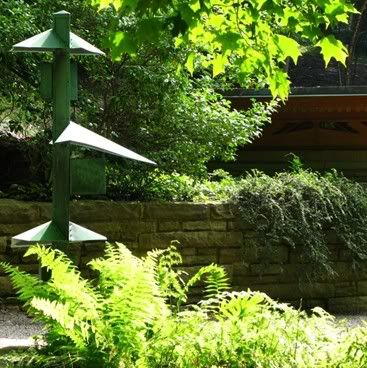 In 1953, I.N. and Bernardine Hagan began conversations with the great architect Frank Lloyd Wright about designing a house for them on an 80-acre property in the Laurel Highlands of Southwestern Pennsylvania. Wright chose the site, a “knob” or large bald hill, known to the locals as Kentuck Knob, where he carefully positioned the home just below the summit of the hill rather than on the top of it. This way the house seems to grow right out of the surrounding hillside. This fusion of architecture and landscape is integral to Mr. Wright’s concept of organic architecture; hence, the home becomes inextricable from the landscape.
In 1953, I.N. and Bernardine Hagan began conversations with the great architect Frank Lloyd Wright about designing a house for them on an 80-acre property in the Laurel Highlands of Southwestern Pennsylvania. Wright chose the site, a “knob” or large bald hill, known to the locals as Kentuck Knob, where he carefully positioned the home just below the summit of the hill rather than on the top of it. This way the house seems to grow right out of the surrounding hillside. This fusion of architecture and landscape is integral to Mr. Wright’s concept of organic architecture; hence, the home becomes inextricable from the landscape.Mr. Wright left all the details of the landscaping to the Hagans, saying only, “Keep it natural.”
In 1956, their first year living in the house, Mr. and Mrs. Hagan expanded the integration between the home and landscape by randomly planting 6,000 tree seedlings throughout the abandoned cornfield that descended down the north side of the knob. The receipt from Mussers Nursery in Indiana, PA, lists White Ash, White Oak, Pin Oak, Sugar Maple, Shellbark Hickory, Tulip Poplar, and Eastern Hemlock. On the south side of the knob, the native woodlands had been timbered and left a mess. Mr. and Mrs. Hagan went on to plant a total of over 8,800 tree seedlings in all, bringing the native woodlands back to life. Many of the remaining fields were allowed to recover naturally, and wildflowers were encouraged.
Bernardine Hagan was an accomplished gardener even before she moved to her new mountain home. She studied landscape design at Carnegie Mellon University in Pittsburgh, PA, and was drawn to Japanese gardens. Though the site at Kentuck Knob was not suitable for a traditional Japanese garden, she employed many of the concepts: gravel paths, stepping stone walks, and boulders as sculpture. In fact, Mrs. Hagan orchestrated a great effort by many dedicated local men to move large boulders around the site for just the right effect.
Robert Taylor of Carnegie Mellon helped design a prominent water feature on the back terrace, and Mrs. Hagan planted heaths, heathers, and many other cushion plants that spilled over the flagstones around it and into the pathway. She also kept bonsai plants on the terrace in the summer.
In 1986, Lord Peter Palumbo, drawn to the brilliant combination of location and design at Kentuck Knob, purchased the property from the Hagans. The Palumbo family have proved committed stewards of this living landscape and are currently working on a plan for an arboretum of native trees on the property. Labels identifying many remarkable specimens are currently being installed, especially near the visitors’ center and in the Sculpture Meadow. This expansive meadow, which houses works by world-renowned sculptors like Sir Anthony Caro and Andy Goldsworthy was turned into lawn some years ago, and is now part of an experiment to return many of the native wildflowers and grasses to this area.
Since the property has been open to the public in 1996, the heavy foot traffic has prohibited the kind of exuberant plantings that once decorated the flagstone pathways. And since no garden is ever static, the shade provided by maturing trees has also placed limits on restoring the previous plant palate. The result was a loss of the delicacy of some of the former design.
But, together with Bernardine Hagan, who celebrated her 100th birthday this year, and her good friend Eleanor Ulmer, the Palumbos are dedicated to preserving the continuity of the original garden design as it grows and changes over time. I, too, am honored to be a part of this wonderful undertaking, and I look forward to sharing it with visitors as it grows through the seasons.
-Laura Tebbitt
Kentuck Knob Director of Horticulture
oldish apprecionist of mr wright from way back, can`t visit but any interior shots ?
ReplyDeleteJohn, thank you for stopping by!
ReplyDeleteDue to Kentuck Knob being privately owned, there is no interior photography permitted; however, we do have some postcards at the gift shop.
If you would like for me to send you a couple, please email me at hmiller@kentuckknob.com.
Best,
Heidi
Heidi Ruby Miller
Kentuck Knob
Educational Marketing Director